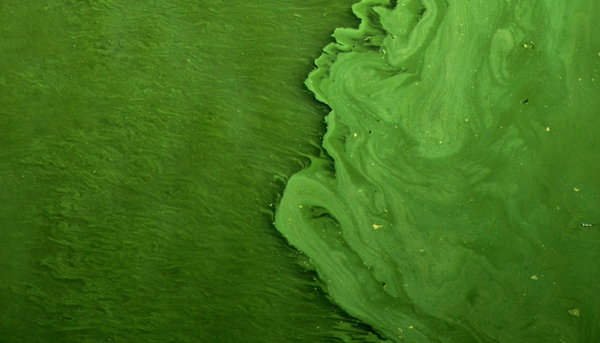Now that summer is in full swing, it's pivotal that we go outside and enjoy the limited supply of warm weather here in Canada. Although many lake-goers are familiar with the importance of using sunscreen or sunblock on their skin to protect from damaging ultraviolet (UV) light from the sun, many may be unfamiliar with the sun's damaging effects on the eye.
Before looking deeper into the sun's effects on the eye, we need to understand a few basic structures in the eye. The eye is composed of many complex structures, but to avoid eyestrain for our readers, let's just highlight the cornea.

Sitting on the outermost portion of the eye, the cornea is the most exposed to the elements including the sun’s harmful UV rays. The cornea is a part of your eye you could touch with your finger (not recommended) and similar to an onion, the cornea is made up of several layers. Each of the cornea’s 5 (debatably 6) layers, has its own distinct function. When UV light enters the eye, damage occurs mainly to the outermost layer, the epithelium.

What is an eye sunburn?
UV light is known to cause sunburn, premature aging and cancer of the skin. Similarly in the eye, UV light is known to cause sunburn, premature aging and cancer of the eye.

A sunburn on the eye has a few fancy names, either photokeratitis, ultraviolet keratitis and more commonly in the wintertime, snow blindness.
In ultraviolet keratitis, little cells on the front surface of your eye (the corneal epithelium) are damaged by the UV light from the sun and begin to die. These dead corneal cells detach from the eye as part of the natural healing process and no longer cover the ultra-sensitive corneal nerves that lie in the layer beneath (corneal stroma).
These corneal nerves do NOT like being exposed, and can cause extreme pain until they are covered by new corneal epithelial cells. Thankfully the eye (specifically the cornea) is able to regenerate very quickly and can heal itself fully within 48 hours due to some handy corneal stem cells lying on the front surface of the eye.
When is an eye sunburn likely to occur?
A sunburn on the eye can occur to anyone spending time outdoors without using proper eye protection. The exact time it takes for your eyes to become damaged from UV light depends on a multitude of factors including air pollution, season, time of day and reflection off of surfaces, and altitude. Since UV is the highest in the summer, some common lake time activities that increase your risk of ultraviolet keratitis include water activities (due to UV reflection off of the water) such as boating, swimming, surfing; hiking/jogging or any other prolonged outdoor activities.

There are many other unsuspecting causes of ultraviolet keratopathy including painting or viewing white surfaces (fences, buildings and snow), arc welding, tanning beds, damaged halide lamps (often found in gymnasiums) or exposure to germicidal UV lights.
What are some symptoms of an eye sunburn?
The common symptoms of ultraviolet keratitis are delayed, and tend to occur 6-12 hours after the UV exposure has occurred. Symptoms vary, but typically occur in both eyes simultaneously and include:
- Severe eye pain
- Decreased vision
- Pain and sensitivity to bright lights
- Watering of the eye (Tearing)
- Facial and eyelid swelling
- Redness
How do you treat an eye sunburn?
Thankfully, the condition is usually “self-limiting” which means it will often heal on its own, within 48-72 hours and is unlikely to cause any long-term damage to the eye. A visit to the eye doctor is still necessary as there are supportive treatments available to minimize pain and other symptoms. Some of these treatments include cool compresses, lubricating ointments and over-the-counter or prescription painkillers.

Some doctors may also initiate preventative anti-bacterial eyedrops depending on the severity of the burn. In rare cases, the damage to the eye caused by the UV light can make way for a bacterial infection which can cause permanent loss of vision if not treated immediately.
Other eye complications from sunlight?
As alluded to earlier, UV light can cause early aging changes and certain eye cancers.
- UV light is known to be an accelerating factor in the development of cataracts. Cataracts are a normal aging related change to the eye that causes slow decreases in vision and require non-urgent surgical intervention.
- UV light has been shown to accelerate the progression of macular degeneration, which is one of most prevalent causes of vision loss in people over the age of 65.
- UV light is a major factor in the development of uveal and other eye cancers. Cancer in the eye is especially dangerous as the eye has a very high rate of blood flow which increases the potential for metastasis of potential cancers.
Don't overlook eye safety this summer
Before we go any further, it must be reiterated that sunscreen should never be used on the eyeballs.
Fortunately, ultraviolet keratopathy and all other eye conditions aggravated by UV can be prevented by proper use of UV-protection sunglasses.

Thankfully in Canada, all glasses marketed as “sunglasses” must be UV-blocking by law; buyer beware - this is not the case in all countries around the world. The amount of UV protection provided by sunglasses is variable and can be anywhere from 60-100% of UV protection.
The amount of UV protection is usually indicated by how dark the tint is on the glasses, with 100% UV protection being the darkest and not recommended for driving.

Many contact lenses incorporate UV protection into their contact lenses and although they may help, they are inferior to sunglasses when it comes to UV protection.
It's been shown that while close to 71% of the population owns a pair of sunglasses, most report only occasional use. This summer, look cool while protecting your eyes and wear your sunglasses!
Eye pain can be a sign of many different eye conditions and diseases, and any eye pain warrants medical attention.






Join the Conversation